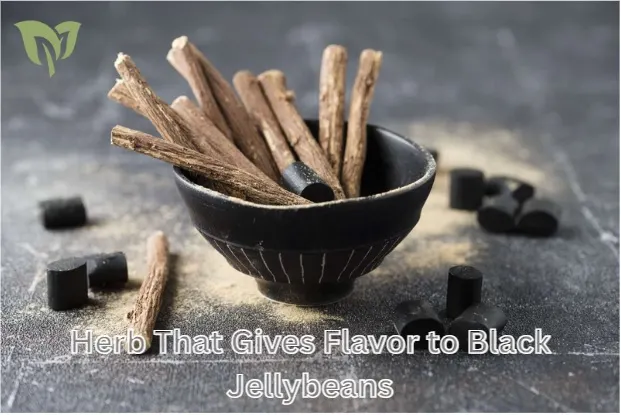Black jelly beans have a wonderful, sturdy taste that sets them aside from the relaxation of the colourful candy lineup. But have you ever ever been puzzled about what herb offers flavor to black jellybeans? The answer lies in a centuries-old medicinal plant that has delighted and divided taste buds for generations.
This herb not only defines the taste of these chewy confections but also has a rich history in traditional medicine and culinary practices. In this article, we’ll explore the herb that gives flavor to black jellybeans, its origins, health benefits, how it’s used in candies, and why it’s both loved and loathed. Plus, we’ll look at consumer trends, product insights, and everything else you need to know about this polarizing flavor.
Table of Contents
What Herb Gives Flavor to Black Jellybeans?
The Secret Ingredient: Licorice Root
The number one herb that offers flavor to black jellybeans is licorice root. Derived from the Glycyrrhiza glabra plant, licorice has an evidently candy and strong flavor often compared to anise or fennel. It is:
- 100 times sweeter than sugar
- A traditional remedy in Chinese and Ayurvedic medicine
- The core flavoring component in traditional black licorice candies
While modern black jellybeans may also include anise oil or artificial licorice flavoring, the original and most iconic taste comes from licorice root.
History of Licorice in Confectionery
Ancient Origins
Licorice root has been used for over 4,000 years, courting back to the historical Egyptians, who prized it for its restoration homes. It was later embraced through the Greeks, Romans, and even discovered in King Tutankhamun’s tomb.
Entry into Candy
The first licorice chocolates appeared in 16th-century Holland and have become widely famous across Europe. In the 20 th century, licorice made its way into jellybeans, giving us the black jellybean we recognize today.
What Does Licorice Taste Like?
Licorice root has a complex, bittersweet flavor. People often describe it as:
- Earthy
- Sweet and spicy
- Reminiscent of anise, fennel, and star anise
Some people love it, while others find it too strong or medicinal. That’s why black jellybeans often rank last in popularity compared to fruit-flavored ones but they also have a devoted fanbase.
Anise vs. Licorice Root: What’s the Difference?
| Feature | Licorice Root | Anise Seed |
| Source Plant | Glycyrrhiza glabra | Pimpinella anisum |
| Flavor Profile | Sweet, earthy, slightly bitter | Sweet, spicy, more aromatic |
| Used In | Black jellybeans, herbal medicine | Liquors like ouzo, sambuca |
| Natural Sweetener | Yes | No |
| Health Benefits | Yes, medicinal properties | Mostly flavor-focused |
Some black jellybeans may include both anise and licorice to achieve a more balanced flavor.
How Black Jellybeans Are Made
1. Base Creation
The candy starts with a starch-molded core of sugar, corn syrup, and pectin.
2. Flavor Infusion
Here’s where the herb that gives flavor to black jellybeans licorice root extract is added. Sometimes mixed with:
- Anise oil
- Molasses
- Clove or cinnamon oils
3. Shell Coating
Each bean is polished with a sugary shell, often dyed black using food coloring like carbon black or vegetable charcoal.
Health Benefits of Licorice Root
While jellybeans are candy, licorice root in its natural form offers several health benefits:
- Soothes digestive issues
- Anti-inflammatory properties
- Helps with sore throat and cough
- Natural antibacterial effects
⚠️ However, excessive consumption can lead to high blood pressure and electrolyte imbalances due to glycyrrhizin.
Popularity and Market Trends
Why Do Some People Hate Black Jellybeans?
The flavor is polarizing. According to surveys:
- 35% of candy eaters avoid black jellybeans
- Licorice fans tend to be over age 40
- Many associate it with medicine or unpleasant childhood experiences
Nostalgia and Niche Appeal
Despite mixed reviews, the herb that gives flavor to black jellybeans remains iconic. Niche brands like Licorice International and Jelly Belly continue to produce them due to consistent demand.
Licorice Around the World
| Country | Licorice Treat Name | Notes |
| Netherlands | Drop | Comes in sweet and salty varieties |
| Finland | Salmiakki | Contains ammonium chloride, very salty |
| UK | Liquorice Allsorts | Mixed candies, often layered |
| USA | Black Jellybeans | Often sweetened with anise or molasses |
| Italy | Pure Licorice Sticks | Strong and unsweetened |
How to Spot Natural Licorice Flavor
When shopping, check ingredient labels. Look for:
- Glycyrrhiza glabra extract (real licorice)
- Anise oil (common substitute)
- Molasses or star anise (used for sweetness)
✅ Brands like Jelly Belly, Gustaf’s, and Panda Licorice use real licorice root in select products.
Summary
The herb that gives flavor to black jellybeans is licorice root, a powerful plant used for centuries in both medicine and confections. With its bold, earthy flavor, it continues to divide candy lovers. While some prefer fruity flavors, licorice jellybeans remain a nostalgic treat for dedicated fans worldwide.
Frequently Asked Questions
Do all black jellybeans contain licorice root?
Not always. Some use anise oil or artificial flavors, but authentic ones include licorice extract.
Why do some people dislike black jellybeans?
The strong, bitter-sweet taste of licorice is polarizing and reminds some people of medicine.
Are black jellybeans healthy?
As candy, they are sugary, but licorice root itself has digestive and anti-inflammatory benefits in moderation.
